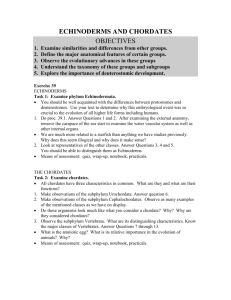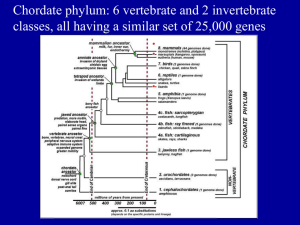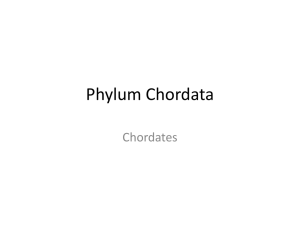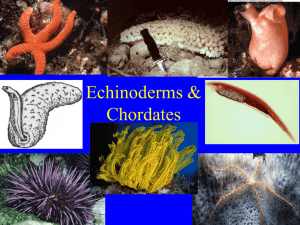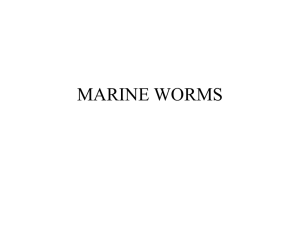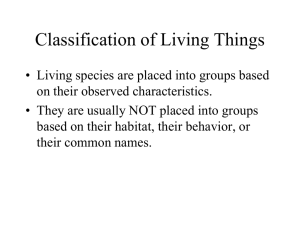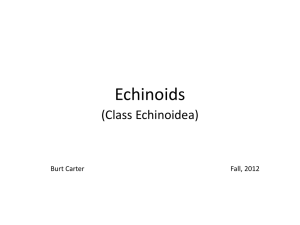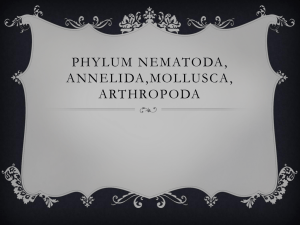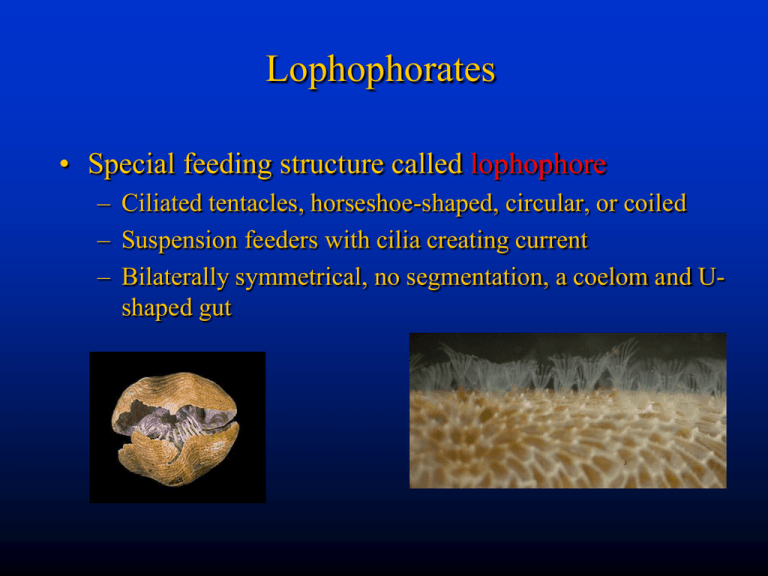
Lophophorates
• Special feeding structure called lophophore
– Ciliated tentacles, horseshoe-shaped, circular, or coiled
– Suspension feeders with cilia creating current
– Bilaterally symmetrical, no segmentation, a coelom and Ushaped gut
Lophophorates
• Phyla
– Ectoprocta (Bryozoans – moss animals)
• Retractable lophophore; colonies of inter connected individuals
(zooids)
– Phoronida (Phoronids)
• Small, worm-like that build tubes made of sand grains
• Burrow in sand attaching tubes to rocks
– Brachiopoda (Lamp Shells or Brachiopods)
• Attached to rocks; shell with two valves, valves open = 2 or more
lophophore
Lophophorates
Ectoprocta
Phoronida
Brachiopods
Phylum Chaetognatha
• Chaetognatha - Arrow Worms
– Smallest animal phyla (100 spp)
– Most common and important member of
plankton (10 cm)
– Transparent, fins, tail, head w/ eyes, grasping
spines, teeth
– Voracious carnivores – small crustaceans,
eggs, and larvae
– Motionless except to grab prey
Phylum Echinodermata
• Echinoderms: Five-Way Symmetry
– Pentamerous radial symmetry
– Oral and aboral surfaces
– Complete digestive tract with developed coelom and
endoskeleton covered with thin layer of ciliated tissue
– Spines and pointed bumps = spiny skin
Phylum Echinodermata
• Water Vascular System
– Tube feet are muscular extensions of canals
– Filled with water by action of muscular sacs (ampullae)
that extend inside body opposite tube feet
– End in sucker used for attachment, locomotion, and
receiving chemical stimuli.
– Sea stars/sea urchins – system connects to outside
through madreporite, porous plate on aboral surface
General Structure Echinoderms
Echinoderms are examples of animals with pentaradial
symmetry. Unlike arthropods, they have an endoskeleton.
They also evert there stomach to eat…
Phylum Echinodermata
• Class Asteroidea (sea stars)
– 5-50 arms radiating from central disk
– Tube feet radiate from ambulacral (am-bu-lak-ral)
groove – channels on each arm
– Endoskeleton – calcium carbonate plates for flexibility
• Aboral surface has spines modified into pincher like organs
called pedicelariae used to keep surface clean
Phylum Echinodermata
• Class Ophiuroidea (Brittle Stars)
–
–
–
–
Long flexible central disk with swift snake like movements
Feet lack suckers
Eat detritus and small animals while buried under sand
Food – from foot to mouth; lack anus
Phylum Echinodermata
• Class Echinoidea (sea urchins)
– Endoskeleton forms round rigid shell-like test with movable spines
• Use spines for locomotion and sucker tipped tube feet (5 rows
of ambulacral grooves)
– Mouth on bottom, anus on top
– Mouth has jaws and muscles for biting algae
– Sand dollars - soft bottoms of oceans – flat bodies and short spines
• Tube feet and mucus to pick up organic matter
Sand dollar
Mellita sexiesperforata
Sea Urchin,
Strongylocentrotus drob
Phylum Echinodermata
• Class Holothuroidea (sea cucumbers)
–
–
–
–
–
Worm-like, lacking radial symmetry
Lies on side w/ 5 rows of feet (oral and aboral at ends)
Endoskeleton composed of small calcarious spicules
Deposit feeders
Some burrow; some secrete toxins; some discharge toxic filaments
through anus
– Evisceration – sudden expulsion of gut or internal organs through
mouth or anus to distract predator
http://www.youtube.com/watch?v=
fq1Dei3G19Q
Phylum Echinodermata
• Class Crinoidea (Crinoids)
– Feather stars and sea lilies – use out stretched feather arms to obtain
food
– Sea - Deep water – attach permanently to bottom
– Feather Star – crawl on hard bottoms of shallow or deep water
– Upside down brittle star w/ 5-200 arms
– Food gets to mouth through ciliated ambulacral grooves
Phylum Echinodermata
• Biology - Feeding and digestion
– Most sea stars are carnivorous
– Everting part of stomach inside out through mouth
• Secretes digestive enzymes made by digestive glands
– Brittle stars have short guts
– Sea Urchin and Sea Cucumber have long guts (digest seaweeds and
sediments)
– Nutrients transported by ceolomic fluid
– Gas exchange takes place across small branched projections
• Sea cucumbers draw water in through anus to respiratory trees
Phylum Echinodermata
• Biology – Nervous System and Behavior
– Presence of nerve net which coordinates movement of tube feet and
spines
– No brain
– Cucumbers may display camouflage or turn over when upside
down
Phylum Echinodermata
• Biology – Reproduction and Life History
– Separate sexes in most cases; broadcast spawning
– Fertilized eggs may develop into ciliated, bilateral larvae and does
not obtain radial symmetry until metamorphosis
– Asexual reproduction – removal of disk and regenerating
– Some may regenerate organism from severed arm
Phylum Hemichordata: A missing link?
• Hemichordates
– Evolutionarily linking chordates with echinoderms
– Larval stages similar to echinoderms, yet have hollow nerve cord
and openings along gut like chordates
– Acorn Worms – deposit feeders; worm like; hydrothermal vents
Phylum Chordata
• Chordates without backbone
– Protochordates – chordates lacking backbone
• Subphylum Urochodata
• Subphylum Cephalochordata
– All developing chordates have single hollow nerve cord
along dorsal side, gill slits, notocord (supports nerve
cord and gut), and post anal tail.
– Ventral Heart
Subphylum Urochordata
• Subphylum Urochordata: Tunicates
– Largest group; all marine with sac like bodies attached
to hard surface (sessile)
– Filter feeders (incurrent siphon)
– Some colonial – share same in and excurrent siphon
– Planktonic larvae (tadpole) contain chordate
characteristics, adults do not
Subphylum Urochordata
• Subphylum Urochordata: Tunicates
– Larvae’s only purpose is to find place to settle (no
feeding)
– Larvaceans planktonic tunics
• Retain tadpole body
• Secretes gelatinous house for protection and filters water
Subphylum Cephalochordata
• Subphylum Cephalochordata: Lancelets
–
–
–
–
Laterally compressed and elongated like fish
Has all chordate characteristics minus backbone
Inhabit soft bottoms
Filter feeders; use gills to capture and concentrate
organic particles


